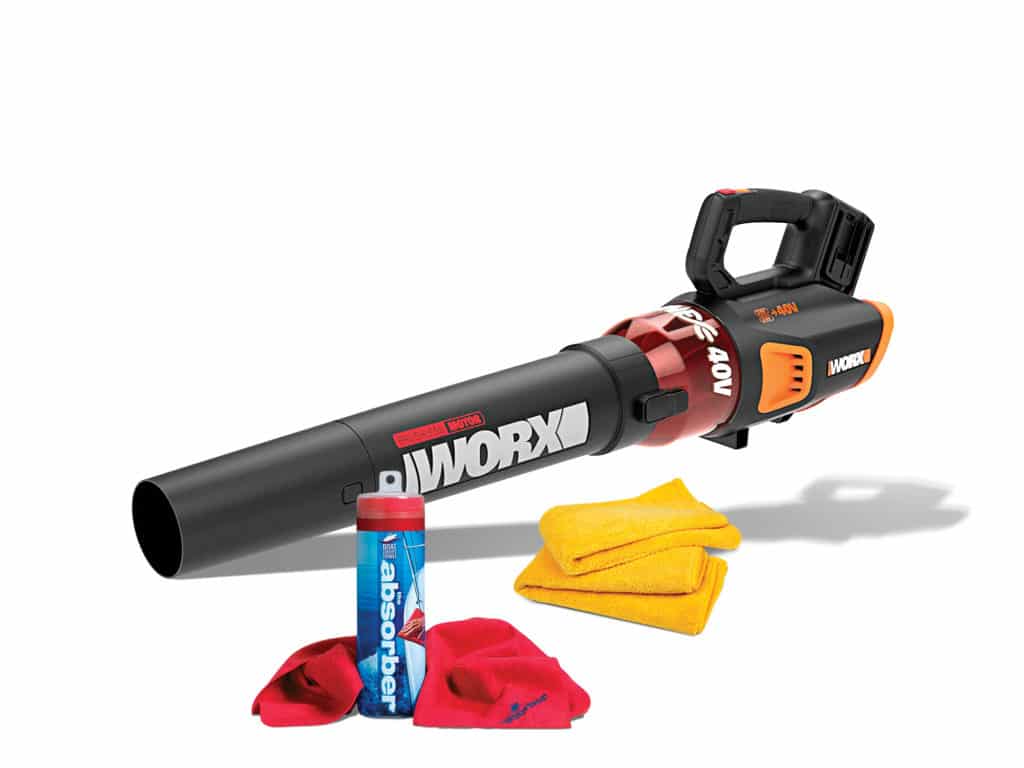
Properly drying your boat is as important as properly washing it. If you just wash, rinse and let water evaporate, hard-water spots develop. The dried minerals leave blemishes that detract from the shine of gelcoat, painted finishes, brightwork, clear enclosures and windows. The longer you neglect to remove such deposits, the more difficult they are to remove, if at all. So, the key to keeping your boat looking good and staving off future work is drying the boat promptly after each wash. Here are implements that can help you do it faster and with less effort.
Read Next: How to Wash a Boat
Squegee
When drying the boat on a hot day, you’re competing with ol’ sol to get the job done first. A squeegee such as the Shurhold Shur-Dry flexible water blade ($25.27, amazon.com) lets you quickly sheet away water from broad surfaces. Start at the uppermost portions of the boat and work your way down. If you can’t reach areas such as a hardtop, use Shurhold’s adapter ($12.98), which fits one of the company’s telescoping handles.
Natural Chamois
There are some surfaces such as rails, cleats and crannies that don’t lend themselves to squeegees. That’s when a chamois skin ($9.77, amazon.com) can come in handy. Many old salts believe there’s nothing better for drying surfaces to a spot-free shine. You’ll have to soak the skin because natural chamois dry out like a stiff board between uses. Once it softens up, wring it out and start wiping. Wring it repeatedly as it absorbs water. On the downside, some believe that natural chamois are more abrasive than synthetic chamois or microfiber towels (see below), and tend to remove the waxed finishes from surfaces.
Synthetic Chamois
Today, synthetic chamois are more prevalent than the natural variety, and one of most ubiquitous aboard boats is the Absorber ($13.99, basspro.com). It comes in a plastic cannister to store between uses. The 27-by-17-inch towel remains soft and pliable between uses. Made of high-tech PVA material, it has a unique open-cell structure that absorbs water three times faster than a regular towel or natural chamois. It is also machine-washable, and can be stored wet without inducing mildew, mold or rot. Wring it out when it’s full of water and then keep drying.
Quick-Dry Mops
Absorbent mops such as the Swobbit Quik Dry mop ($38.37, amazon.com) use synthetic chamois strips, and are great for nonskid surfaces and tight spots. The Quik Dry mop can be wrung out by hand once it reaches its saturation point, which is five times its weight in fluids. It attaches to the Swobbit Perfect Pole telescoping handle ($38.99 for 5- to 9-foot model). Use it to dry tall structures such as the upper pipework of a tuna tower that you cannot reach.
Microfiber Towels
These gentle fabrics are great for wiping down just about anything on a boat, but microfiber towels ($10.99, basspro.com) aren’t as absorbent as chamois products, so you will be wringing them out more often. Many boaters reserve microfiber towels for drying the most delicate surfaces such as clear acrylic and polycarbonate windshields and enclosure curtains that tend to scratch and mar more easily than other surfaces. Make sure the towel is clean and free of salt or other grit that can inflict scratches.
Leaf Blower
On cool days, you’re not racing the sun. In fact, you’re looking for ways to shed water more quickly after you rinse the boat. That’s when a cordless leaf blower such as the Worx 40V Power Share Turbine ($99, amazon.com) can help. Use it to whisk sheets of water away from decks, windows and other surfaces before you do a final wipe down to leave the boat dry, shining and free of hard-water spots.









